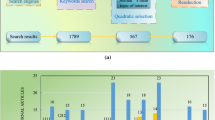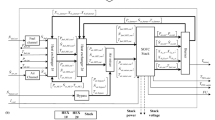Abstract
Fuel cell system is a complicated system that requires an efficient controller. Model predictive control is a prime candidate for its optimization and constraint handling features. In this work, an improved model predictive control (MPC) with Laguerre and exponential weight functions is proposed to control fuel cell oxygen starvation problem. To get the best performance of MPC, the control and prediction horizons are selected as large as possible within the computation limit. An exponential weight function is applied to place more emphasis on the current time and less emphasis on the future time in the optimization process. This leads to stable numerical solution for large prediction horizons. Laguerre functions are used to capture most of the control trajectory, while reducing the controller computation time and memory for large prediction horizons. Robustness and stability of the proposed controller are assessed using Monte-Carlo simulations. Results verify that the modified MPC is able to mimic the performance of the infinite horizon controller, discrete linear quadratic regulator (DLQR). The controller computation time is reduced approximately by one order of magnitude compared to traditional MPC scheme. Results from Monte-Carlo simulations prove that the proposed controller is robust and stable up to system parameters uncertainty of 40%.
Similar content being viewed by others
References
J. Larminie and A. Dicks, Fuel cell systems explained, Second Ed. John Wiley & Sons Ltd, Chichester, West Sussex, England (2003).
C. A. Andersen, M. O. Christensen and A. R. Korsgaard, Design and control of fuel cell system for transport application, Aalborg University, Aalborg, Denmark (2002).
S. W. Ji, N. S. Myung and T. S. Kim, Analysis of operating characteristics of a polymer electrolyte membrane fuel cell coupled with an air supply system, Journal of Mechanical Science and Technology, 25(4) (2011) 945–955.
D. Xuan, Z. Li, J. Kim and Y. Kim, Optimal operating points of PEM fuel cell model with RSM, Journal of Mechanical Science and Technology, 23 (2009) 717–728.
E. A. M. Ali and A. Abudhair, A survey of the relevance of control system for PEM fuel cells, International Conference on Computer, Communication, and Electrical Engineering, Tamilnadu, India (2011) 322–326.
F. Zenith, Control of fuel cells, Norwegian University of Science and Technology, Norwegian, Norway (2007).
H. S. Kim, Experimental investigation of dynamic responses of a transparent PEM fuel cell to step change in cell current density with operating temperature, Journal of Mechanical Science and Technology, 22(11) (2008) 2274–2285.
S. W. Ji, B. J. Ryu, S. K. Park and T. S. Kim, Influence of thermal management and integration with turbomachinary on the performance of polymer electrolyte membrane fuel cell system, Journal of Mechanical Science and Technology, 25(7) (2011) 1861–1870.
J. T. Pukrushpan, Modeling and control of the fuel cell systems and fuel processors, University of Michigan, Ann Ar bor, Michigan, USA (2003).
P. Rodatz, G. Paganelli and L. Guzella, Optimizing air supply control of a PEM fuel cell system, Proc. of American Control Conference, Denver, Colarado, USA, 3 (2003) 2043–2048.
M. Y. El-Sharkh, A. Rahman, and M. Alam, Neural networks based control of active and reactive power of a satnd-alone PEM fuel cell plant, Journal of Power Sources, 135(2) (2004) 88–94.
S. W. Tong, D. W. Qian, J. J. Fang and H. X. Li, Integrated modelling and variable universe fuzzy control of a hydrogen-air fuel cell system, International Journal of Electrochemical Science, 8(3) (2013) 3636–3652.
V. Shishodia, Enhanced control peformance and application to fuel cell systems, University of Florida, Florida, USA (2008).
A. Vahidi, A. G. Stefanopoulou and H. Peng, Model predictive control for starvation prevention in a hybrid fuel cell system, Proc. of American Control Conference, Boston, MA, USA, 1 (2004) 834–839.
X. Chen, X. Li, H. Su, Z. Cao and B. Zhang, Multiple model predictive control for oxygen starvation prevention of fuel cell system, International Conference on Automatic Control and Artificial Inteligence, Xiamen, China (2012) 1368–1371.
Y. X. Wang, and Y. B. Kim, Real time control for air excess ratio of a PEM fuel cell, ASME Transactions on Mechatronics (99) (2013) 1–10.
L. Wang, Model predictive control system design and implementation using MATLAB, Springer-Verlag, London, England (2009).
P. Bauer, Optimal tracking control for unmanned aerial vehicles, Budapest University of Technology and Economics, Budapest, Hungary (2013).
M. Idres and R. Kafafy, Dynamic thermal model for proton exchange mambrane fuel cell, International Conference on Sustainable Mobility, Kuala Lumpur, Malaysia (2010) 1–10.
M. Idres, R. Kafafy and W. Faris, Air tansient supply system transient model for proton exchange mambrane fuel cell, International Journal of Vehicle System Modelling and Testing, 6(3) (2011) 396–407.
S. S. L. Rao and A. Shaija, Mathematical modeling and performance analysis of proton exchange membrane fuel cell, International Conference on Power, Energy and Control, IEEE (2013).
R. Tempo, E. W. Bai and F. Dabbene, Probabilistic robustness analysis: Explicit bounds for the minimum number of samples, Proc. of Conference on Decision and Control, Kobe, Japan, 35 (1996) 3424–3428.
C. Kunusch, P. F. Puleston, M. A. Mayosky and J. Riera, Sliding mode strategy for PEM fuel cells stacks breathing control using a super-twisting algorithm, IEEE Trans. On Control System Technology, 17(1) (2009) 167–174.
J. H. Lee and Z. H. Yu, Tuning of model predictive control for robust pefromance, Journal of Computer and Chemical Engineering, 18(1) (1994) 15–37.
Author information
Authors and Affiliations
Corresponding author
Additional information
Recommended by Editor Yong-Tae Kim
Muhammad Abdullah received his B.Sc. in Mechanical (Automotive) Engineering from International Islamic University Malaysia in 2011. Currently, he is a Master student in the same university.
Moumen Idres received his B.Sc. and M.Sc. in Aerospace Engineering from Cairo University in 1992 and 1995, respectively. In 1995, he received his doctorate in Engineering Mechanics from Old Dominion University, USA. He is on leave from Aerospace Engineering Department, Cairo University. Currently, he is an Assistance Professor at International Islamic University Malaysia.
Rights and permissions
About this article
Cite this article
Abdullah, M., Idres, M. Fuel cell starvation control using model predictive technique with Laguerre and exponential weight functions. J Mech Sci Technol 28, 1995–2002 (2014). https://doi.org/10.1007/s12206-014-0348-3
Received:
Revised:
Accepted:
Published:
Issue Date:
DOI: https://doi.org/10.1007/s12206-014-0348-3




